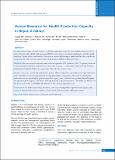Please use this identifier to cite or link to this item:
https://hdl.handle.net/20.500.14356/1848Full metadata record
| DC Field | Value | Language |
|---|---|---|
| dc.contributor.author | Kumal, A B | - |
| dc.contributor.author | Mahato, R K | - |
| dc.contributor.author | Gupta, R P | - |
| dc.contributor.author | Ghimire, J | - |
| dc.date.accessioned | 2023-05-26T06:47:18Z | - |
| dc.date.available | 2023-05-26T06:47:18Z | - |
| dc.date.issued | 2013 | - |
| dc.identifier.citation | Gupta RP, Ghimire J,K. A. M. R. (2013). Human Resource for Health Production Capacity in Nepal: A Glance. Journal of Nepal Health Research Council. https://doi.org/10.33314/jnhrc.v0i0.379 | en_US |
| dc.identifier.issn | Print ISSN: 1727-5482; Online ISSN: 1999-6217 | - |
| dc.identifier.uri | http://103.69.126.140:8080/handle/20.500.14356/1848 | - |
| dc.description | Special Issue Articles | en_US |
| dc.description.abstract | Abstract Background: Shortage of human resources for health is apparent in Nepal. The current HRH strategy has tried to address the demand for skilled birth attendants, MDGPs, Gynecologists, Anesthetists, Radiologists and other health workforce. Despite the increased number of institutions, there is still shortage of health workforce due to ineffective monitoring. This study was undertaken to find out the situation of HRH production in Nepal. Methods: This cross sectional study was conducted from September 2012 to February 2013. The primary focus was on the quantitative method by using the format for the data collection. The main study samples were the academic institutions of Nepal. The finding was analyzed and tabulated in the summary form. Results: There were a total of 294 institutions to produce different cadres of health workforce in Nepal. Staff nurses (101) and CMAs (76) have been produced by the maximum number of institutions. The result revealed that the institutions were not producing the graduates upon their capacity, only 1,451 staff nurse graduated annually against the capacity of producing 4,017 per annum. Although Nepal has a capacity to produce 1,760 MBBS, 267 MD and 116 MS doctors, only 1,074 Nepali MBBS, 222 MD and 95 MS doctors graduated per year. Conclusions: The health institutions performance is lower in producing HRH compared to their capacity in the country. A long-term effort is now required to match demand and supply of the HRH in the country. | en_US |
| dc.language.iso | en | en_US |
| dc.publisher | Nepal Health Research Council | en_US |
| dc.relation.ispartofseries | May-Aug, 2013;379 | - |
| dc.title | Human Resource for Health Production Capacity in Nepal: A Glance | en_US |
| dc.type | Journal Article | en_US |
| local.journal.category | Special Issue Articles | - |
| Appears in Collections: | Vol. 11 No. 2 Issue 24 May - Aug, 2013 | |
Files in This Item:
| File | Description | Size | Format | |
|---|---|---|---|---|
| 379-Article Text-403-1-10-20131127.pdf | Fulltext Download | 378.74 kB | Adobe PDF |  View/Open |
Items in DSpace are protected by copyright, with all rights reserved, unless otherwise indicated.
